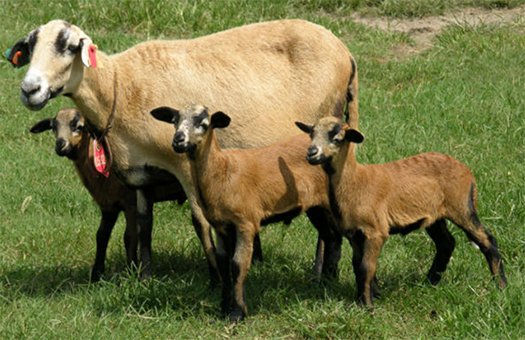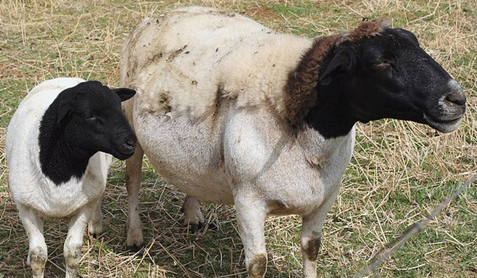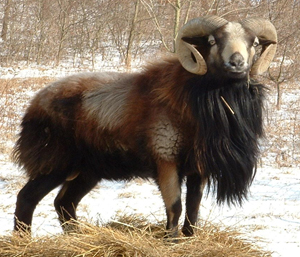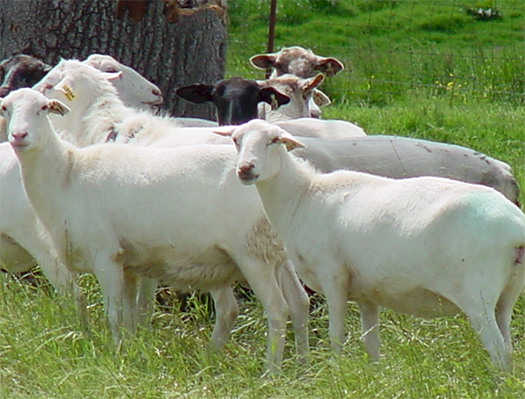Characteristics and General Production Parameters of Hair Sheep Breeds
By
Basil Bactawar, UF/IFAS Duval County Extension Service
The breeds of hair sheep that are of importance in Florida include Katahdin, St. Croix, American Blackbelly, and Barbados Blackbelly. Some of the ancestors of these breeds originated in Africa and were brought to the Caribbean Islands, Central America and northern South America during the 18th and 19th century. Some European sheep genetics were incorporated into the African sheep to arrive at the existing hair breeds mentioned above. These breeds are called hair sheep because the coat consists of hair more like that of cattle and many goats rather than wool. The Dorper is not a true hair sheep, but is included in this fact sheet because it is used in cross breeding programs involving hair sheep.
Hair sheep have some attributes that make them admirably suited to fill market niches or fit varying production systems in Florida. For instance, they have extended breeding season, and can be used to produce lambs to be marketed when lamb prices are usually high thereby reducing marketing risks. In addition, shearing is not a requirement thereby reducing operational cost. They shed their winter coats during spring and early summer. They are the generally more fertile in hot humid regions and show greater tolerance to parasites than woolen breeds. They have less subcutaneous fat on average and are a bit leaner because there is less feathering in the muscles. In general they have low maintenance requirements.
The major disadvantage is that they grow slower and produce a lighter weight carcass than most breeds of European origin. This is true for Barbados Blackbelly and St. Croix in particular, because they have not been subjected to selection for size and growth rate of the woolen breeds. However, they are suitable for markets requiring smaller carcass size. Dorper and Katahdin are medium size breeds. Crossing these breeds with woolen breeds for efficient meat production does hold some potential.
Some general information on hair sheep is found on the next page. This information may be used to compare breeds of hair sheep. It should be kept in mind that performance varies greatly with genetic, management, climate, etc. and, as such, the data are estimates. One needs to do a detail review of the information related to the hair breed one wishes to raise.
BARBADOS BLACKBELLY

Photo courtesy of: Dr. Stephan A. Wildeus
Origin: This breed was developed or evolved on the Eastern Caribbean Island of Barbados. The ancestry is believed to be of both African hair sheep and European breeds.
Coat & Color: The coat can be reddish brown, tan or yellow. The entire belly is black including areas between the legs, nose and forehead.
Mature Weight (Lb): Ewe = 70 -120, Ram = 110 – 140
Disposition & Mothering Ability: This breed is a bit flighty. They are attentive, protective, and make excellent mothers.
Environmental Adaptability:They are adaptable to all climates. Their main advantage is that they adapt well to hot humid climate where woolen breeds do not thrive well.
Breeding Season: They breed throughout the year. Ewes will breed back before the lambs are weaned.
Lambing Interval:It ranges from 6 to 8 months. It is common to have ewes lambing twice per year.
Lambing %: 150 – 230 per lambing.
Average Birth Weight (Lbs): 7 lbs for small lambs, 4-5 lbs for twin lambs.
Weight Gain/Daily: 0.4 lbs daily with good nutrition.
Market Weight/Live/Age: 60 – 80 lbs / 9 month
Dressing %: 48 – 50%
DORPER

Photo courtesy of: Susan Schoenian
Origin: This mutton breed was developed in South Africa in the 1930’s from Dorset Horn and Blackheaded Persia for the extensive regions of South Africa. This is not a true hair sheep.
Coat & Color: Solid white or white with black head. Difference in color is a matter of preference. The coat is a mixture of hair and wool and will shed from animal in late spring/early summer.
Mature Weight (Lb): Ewe = 170 – 200 (can be less than 170lb), Ram = 220 – 250
Disposition & Mothering Ability: Ewes are docile with good mothering ability. Produce large amount of milk.
Environmental Adaptability: Well adapted to hot, dry, humid and wet conditions. They are hardy and do well in range. Non selective grazers that perform well under both extensive and intensive production systems. When selecting breeding stock, choose animals with good feet.
Breeding Season: Long / Extended
Lambing Interval: Can be 8 months
Lambing %: Given an average lambing percent of 150 and 3 lambing in 2 years, Dorper will produce 2.25 lambs on an annual basis.
Average Birth Weight (Lbs): 9.5 lbs.
Weight Gain/Daily: 1 pound under intensive production.
Market Weight/Live/Age: 110 – 130 lbs.
Dressing %: 50%
AMERICAN BLACKBELLY

Photo courtesy of: Dr. Stephan A. Wildeus
Origin: This breed is sometimes referred to as “Barbados Blackbelly,” but it is different from the polled Barbados as a result of crosses with European breeds. This breed was imported in the US in 1904 and was crossed with Mouflon (wild sheep), Rambouillet and other European breeds to produce what is known as American Blackbelly.
Coat & Color: Has a variety of color ranging from black and tan through yellow with variegated mottled pattern. Black color covers belly, inside legs and thighs and extends up to the neck. In winter puts on coat that is shed as temperatures increase. Rams generally have horns.
Mature Weight (Lb): Ewe = 100 – 130, Ram = 120 – 150
Disposition & Mothering Ability: Extremely reactive to dogs and cats usually as though they wish to flee. It is more flighty than Dorper, Kathadin and St. Croix breeds. Ewes with young lambs show protective behavior and may raise front feet to strike dogs and cats when confronted. Have good flocking instinct.
Environmental Adaptability: Withstand heat and cold well, and part of this adjustment to extremes is behavioral. For example, cold wind and warm sun quickly result in herd finding shelter under conditions when woolen sheep remain in the open.
Breeding Season: Year Round
Lambing Interval: 7 – 9 months
Lambing %: Average lambing rate is between 150 and 250%. If ewes are fed well, lambing rate approaches the higher end.
Average Birth Weight (Lbs): 6.5 lbs.
Weight Gain/Daily: 0.5 lbs daily
Market Weight/Live/Age: 70 – 90 lbs / 7 – 8 months
Dressing %: 51%
KATHADIN

Photo courtesy of: Dr. Stephan A. Wildeus
Origin: This breed originated from Maine, U.S. from crosses of woolen breeds mainly Suffolk and later Wiltshire Horn with hair sheep from the Virgin Islands. This breed was developed after 20 years of breeding and selection.
Coat & Color: Coat can be any color or color pattern. Hair coat becomes thick and long as cold weather sets in and the length decreases. Sheds coat as temperature and day length increase. Some Ewes shed coats after second lambing.
Mature Weight (Lb): Ewe = 120 - 160, Ram = 180 – 250
Disposition & Mothering Ability: Ewes have good mothering ability and lamb easily unassisted. Good milkers, and is suggested not to wean lambs before three months.
Environmental Adaptability: Tolerant of both high and low temperatures. Breed ideal for pasture lambing and grass/forage based management systems.
Breeding Season: Long / Extended
Lambing Interval: 8 – 12 months
Lambing %: Approximately 125%, exceeding 200% with subsequent lambing.
Average Birth Weight (Lbs): 8.0 lbs
Weight Gain/Daily: 0.57 lbs under intensive production.
Market Weight/Live/Age: 80 – 110 lbs / 5.5 – 6 months
Dressing %: 54%
ST. CROIX

Photo courtesy of: Susan Schoenian
Origin: Developed in the Virgin Islands for crosses of West African hair sheep and Wiltshire Horn. In 1975 Utah State University imported a small flock of Virgin Island White which is the basis for the present St. Croix breed in North America.
Coat & Color: Most of the individuals are white, but tan and spotted ones exist. Breed is mainly free of wool and do not normally require shearing.
Mature Weight (Lb): Ewe = 130 – 140 (Average is 136), Ram = 170 - 200
Disposition & Mothering Ability: Breed is docile and calm with good flocking instinct. They are excellent mothers.
Environmental Adaptability: Withstand higher heat and humidity than British sheep breeds. In colder zones they produce a very heavy winter coat that is shed in spring. They are excellent foragers.
Breeding Season: Year Round
Lambing Interval: 7 – 9 months
Lambing %: Lambing rates vary from 150% to 250% with 3 lambing every 2 years not uncommon.
Average Birth Weight (Lbs): 7.5 lbs for single, 6.5 – 7 for twins, and less for triplets.
Weight Gain/Daily: 0.5 lbs daily
Market Weight/Live/Age: 110 lbs / 7 – 8 months
Dressing %: 50%
.png)